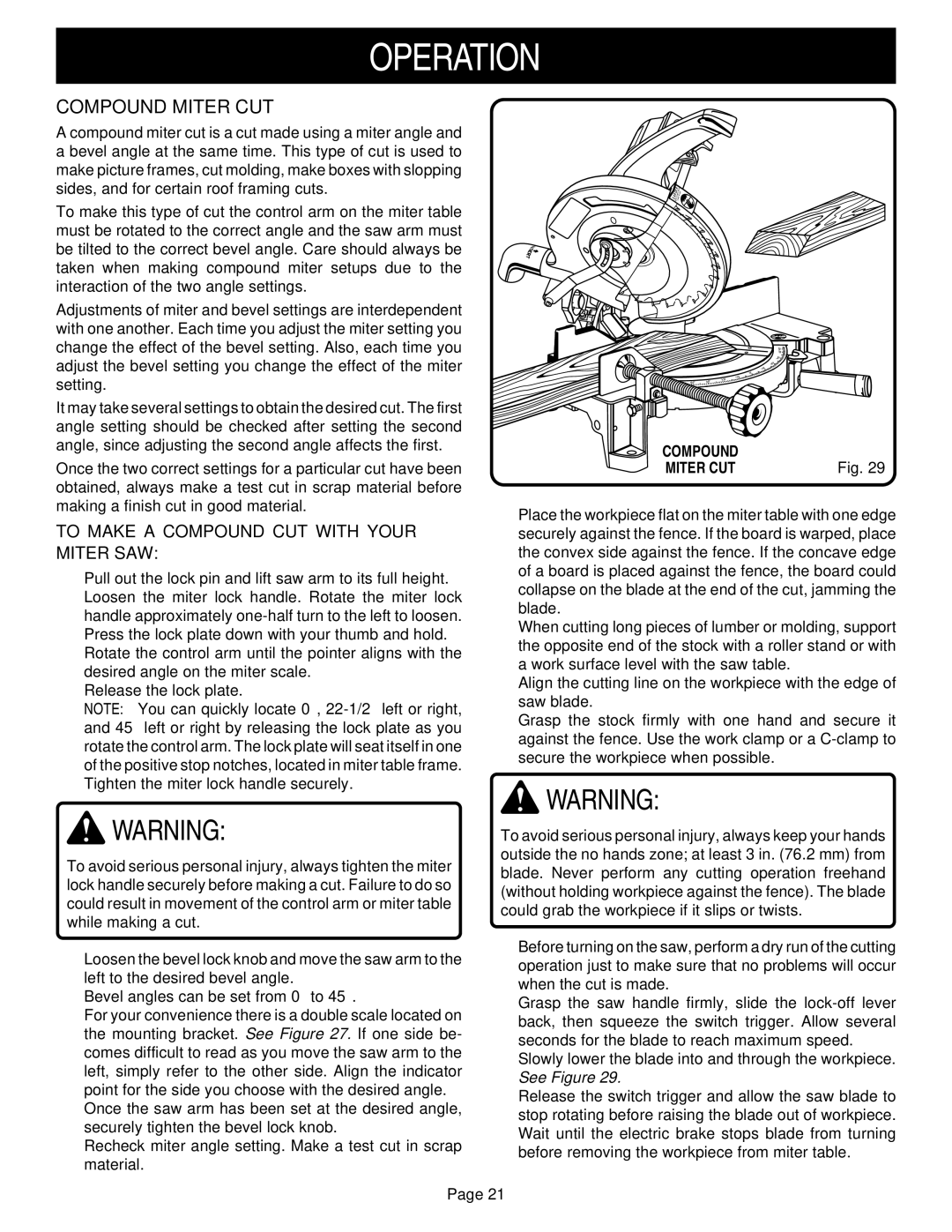
OPERATION
COMPOUND MITER CUT
A compound miter cut is a cut made using a miter angle and a bevel angle at the same time. This type of cut is used to make picture frames, cut molding, make boxes with slopping sides, and for certain roof framing cuts.
To make this type of cut the control arm on the miter table must be rotated to the correct angle and the saw arm must be tilted to the correct bevel angle. Care should always be taken when making compound miter setups due to the interaction of the two angle settings.
Adjustments of miter and bevel settings are interdependent with one another. Each time you adjust the miter setting you change the effect of the bevel setting. Also, each time you adjust the bevel setting you change the effect of the miter setting.
It may take several settings to obtain the desired cut. The first angle setting should be checked after setting the second angle, since adjusting the second angle affects the first.
Once the two correct settings for a particular cut have been obtained, always make a test cut in scrap material before making a finish cut in good material.
TO MAKE A COMPOUND CUT WITH YOUR MITER SAW:
■Pull out the lock pin and lift saw arm to its full height.
■Loosen the miter lock handle. Rotate the miter lock handle approximately
■Press the lock plate down with your thumb and hold.
■Rotate the control arm until the pointer aligns with the desired angle on the miter scale.
■Release the lock plate.
NOTE: You can quickly locate 0° ,
■Tighten the miter lock handle securely.
![]() WARNING:
WARNING:
To avoid serious personal injury, always tighten the miter lock handle securely before making a cut. Failure to do so could result in movement of the control arm or miter table while making a cut.
■Loosen the bevel lock knob and move the saw arm to the left to the desired bevel angle.
■Bevel angles can be set from 0° to 45° .
■For your convenience there is a double scale located on the mounting bracket. See Figure 27. If one side be- comes difficult to read as you move the saw arm to the left, simply refer to the other side. Align the indicator point for the side you choose with the desired angle.
■Once the saw arm has been set at the desired angle, securely tighten the bevel lock knob.
■Recheck miter angle setting. Make a test cut in scrap material.
ER
G
N
A
D
| I |
S | N |
54 0 4
3 0
20
10 0
| 20 |
4 0 | 30 |
COMPOUND |
|
MITER CUT | Fig. 29 |
■Place the workpiece flat on the miter table with one edge securely against the fence. If the board is warped, place the convex side against the fence. If the concave edge of a board is placed against the fence, the board could collapse on the blade at the end of the cut, jamming the blade.
■When cutting long pieces of lumber or molding, support the opposite end of the stock with a roller stand or with a work surface level with the saw table.
■Align the cutting line on the workpiece with the edge of saw blade.
■Grasp the stock firmly with one hand and secure it against the fence. Use the work clamp or a
![]() WARNING:
WARNING:
To avoid serious personal injury, always keep your hands outside the no hands zone; at least 3 in. (76.2 mm) from blade. Never perform any cutting operation freehand (without holding workpiece against the fence). The blade could grab the workpiece if it slips or twists.
■Before turning on the saw, perform a dry run of the cutting operation just to make sure that no problems will occur when the cut is made.
■Grasp the saw handle firmly, slide the
■Slowly lower the blade into and through the workpiece. See Figure 29.
■Release the switch trigger and allow the saw blade to stop rotating before raising the blade out of workpiece. Wait until the electric brake stops blade from turning before removing the workpiece from miter table.
Page 21
